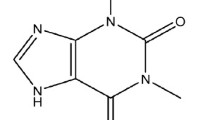Summary
Diabetes may alter the pharmacokinetics of aminopyrine and antipyrine, which are used to assess liver function. Caffeine has recently been used to test liver function, but the effect of diabetes on caffeine kinetics is not known.
The kinetics of caffeine has been examined in patients with decompensated Type I and Type II diabetes and in two age- and sex-matched control groups. In both types of diabetes the apparent caffeine clearance, half-life, and apparent volume of distribution were similar to controls.
It is concluded that decompensated diabetes does not influence the cytochrome P-448 mono-oxygenase system responsible for caffeine metabolism.
Similar content being viewed by others
References
Faas FH, Carter WJ (1980) Cytochrome P-450 mediated drug metabolism in the streptozotocin diabetic rat. Horm Metabol Res 12: 706–707
Daintith H, Stevenson IH, O'Malley KO (1976) Influence of diabetes mellitus on drug metabolism in man. Int J Clin Pharmacol 13: 55–58
Reinke LA, Stohs SJ, Rosenberg H (1978) Altered activity of hepatic mixed-function mono-oxygenase enzymes in streptozotocin-induced diabetic rats. Xenobiotica 8: 611–619
Zysset T, Sommer L (1986) Diabetes alters drug metabolism — in vivo studies in a streptozotocin-diabetic rat model. Experientia 42: 560–562
Zysset T, Tlach C (1987) Altered liver function in diabetes: Model experiments with aminopyrine in the rat. J Pharmacol Exp Ther 240: 271–276
Zysset T, Wietholtz H (1988) Differential effect of Type I and Type II diabetes on antipyrine disposition in man. Eur J Clin Pharmacol 34: 369–375
Past MR, Cook DE (1982) Effect of diabetes on rat liver cytochrome P-450. Evidence for a unique diabetes-dependent rat liver cytochrome P-450. Biochem Pharmacol 31: 3329–3334
Bircher J, Küpfer A, Gikalov I, Preisig R (1976) Dose dependence of the14C-aminopyrine breath test. Clin Pharmacol Ther 20: 484–492
Hepner GW, Vesell ES (1974) Assessment of aminopyrine metabolism in man by breath analysis after oral administration of14C-aminopyrine. Effects of phenobarbital, disulfiram and portal cirrhosis. N Engl J Med 291: 1384–1388
Saunders JB, Lewis KO, Paton A (1980) Early diagnosis of alcoholic cirrhosis by the aminopyrine breath test. Gastroenterology 79: 112–114
Andreasen PB, Greisen G (1976) Phenazone metabolism in patients with liver disease. Eur J Clin Invest 6: 21–26
Vestal RE, Norris AH, Tobin JD, Cohen BJH, Shock NW, Andres R (1975) Antipyrine metabolism in man: influence of age, alcohol, caffeine, and smoking. Clin Pharmacol Ther 18: 425–432
Teunissen MWE, Spoelstra P, Koch CW, Weeda B, Van Duyn W, Janssens AR, Breimer DD (1984) Antipyrine clearance and metabolite formation in patients with alcoholic cirrhosis. Br J Clin Pharmacol 18: 707–715
Vesell ES (1979) The antipyrine test in clinical pharmacology: conceptions and misconceptions. Clin Pharmacol Ther 26: 275–286
Jost G, Wahlländer A, von Mandach U, Preisig R (1987) Overnight salivary caffeine clearance: a liver function test suitable for routine use. Hepatology 7: 338–344
Renner E, Wietholtz H, Huguenin P, Arnaud MJ, Preisig R (1984) Caffeine: a model compound for measuring liver function. Hepatology 1: 38–46
Wahlländer A, Renner E, Preisig R (1985) Fasting plasma caffeine concentration. A guide to severity of chronic liver disease. Scand J Gastroenterol 20: 1133–1141
Wietholtz H, Vögelin M, Arnaud MJ, Bircher J, Preisig R (1981) Assessment of the cytochrome P-448 dependent liver enzyme system by a caffeine breath test. Eur J Clin Pharmacol 21: 53–59
Perucca E, Hedges A, Makki KA, Ruprah M, Wilson JF, Richens A (1984) A comparative study of the relative enzyme inducing properties of anticonvulsant drugs in epileptic patients. Br J Clin Pharmacol 18: 401–410
Melani F, Rubenstein AH, Oyer PE, Steiner DF (1970) Identification of proinsulin and C-peptide in human serum by a specific immunoassay. Proc Natl Acad Sci USA 67: 541
Zysset T, Wahlländer A, Preisig R (1984) Evaluation of caffeine plasma levels by an automated enzyme immunoassay (EMIT) in comparison with a high-performance liquid chromatographic method. Ther Drug Monit 6: 348–354
Bonati M, Latini R, Galletti F, Young JF, Tognoni G, Garattini S (1982) Caffeine disposition after oral doses. Clin Pharmacol Ther 32: 98–106
Wissenschaftliche Tabellen Geigy (1980) Teilband Statistik, 8. Auflage, Ciba-Geigy Ldt. Basle, Switzerland
Welborn TA, Garcia-Webb P, Bonser AM (1981) Basal C-peptide in the discrimination of type I from Type II diabetes. Diabetes Care 4: 616–619
Desmond P, Patwardhan RH, Johnson RF, Schenker S (1980) Impaired elimination of caffeine in cirrhosis. Dig Dis Sci 25: 193–197
Parsons WD, Neims AH (1978) Effect of smoking on caffeine clearance. Clin Pharmacol Ther 24: 40–45
Schnegg M, Lauterburg BH (1986) Quantitative liver function in the elderly assessed by galactose elimination capacity, aminopyrine demethylation and caffeine clearance. J Hepatol 3: 164–171
Wietholtz H, Zysset Th, Kreiten K, Kohl D, Büchsel R, Matern S (1989) Effect of phenytoin carbamazepine and valproic acid on caffeine metabolism. Eur J Clin Pharmacol 36: 401–406
Camilleri M, Malagelada JR (1984) Abnormal intestinal motility in diabetics with the gastroparesis syndrome. Eur J Invest 14: 420–427
Saltzman MB, McCallum RW (1983) Diabetes and the stomach. Yale J Biol Med 56: 179–187
Nakanome C, Akai H, Hongo M, Imai N, Toyota T, Goto Y, Okuguchi F, Komatsu K (1983) Disturbances of the alimentary tract motility and hypermotilinemia in the patients with diabetes mellitus. Tohoku J Exp Med 139: 205–215
Murali KV, Adithan C, Shashindran CH, Gambhir SS, Chandrasekar S (1983) Antipyrine metabolism in patients with diabetes mellitus. Clin Exp Pharmacol Physiol 10: 7–13
Campbell ME, Grant DM, Inaba T, Kalow W (1987) Biotransformation of caffeine, paraxanthine, theophylline, and theobromine by polycyclic aromatic hydrocarbon-inducible cytochrome(s) P-450 in human liver microsomes. Drug Metab Dispos 15: 237–249
Nebert DW, Negishi M (1982) Multiple forms of cytochrome P-450 and the importance of molecular biology and evolution. Biochem Pharmacol 31: 2311–2317
Author information
Authors and Affiliations
Rights and permissions
About this article
Cite this article
Zysset, T., Wietholtz, H. Pharmacokinetics of caffeine in patients with decompensated type I and type II diabetes mellitus. Eur J Clin Pharmacol 41, 449–452 (1991). https://doi.org/10.1007/BF00626367
Received:
Accepted:
Issue Date:
DOI: https://doi.org/10.1007/BF00626367




